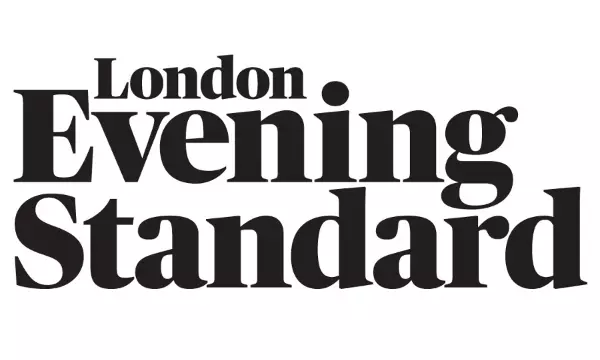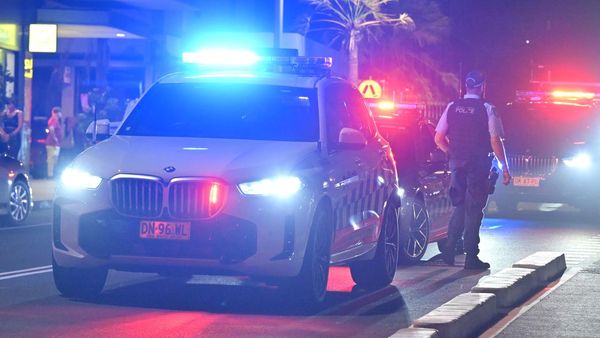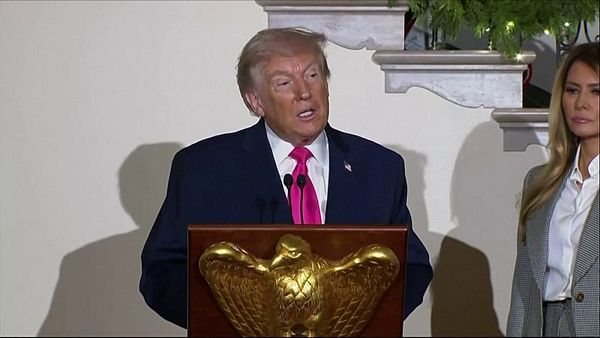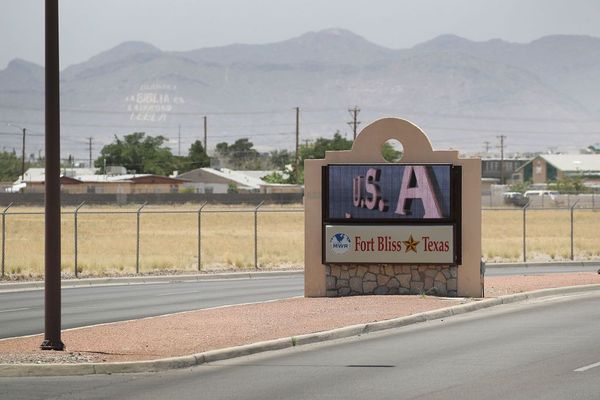
Brother's MFC-J4535DW ($250) is a multifunction printer that's speedy and cost-effective. Using high-capacity cartridges to keep ink costs low, the MFC-J4535DW offers costs per page that rival models with refillable ink tanks. Outfitted with both an automatic document feeder (ADF) and a duplexer for two-sided printing, this multi-function unit is well suited to most small office tasks. In addition to printing, copying and scanning, the MFC-J4535DW offers fax capability.
According to Brother, this multifunction printer comes with up to one year's worth of ink. Your mileage may vary, of course, but considering that the black ink cartridge is rated to print 3,000 pages, and the color ink cartridges are rated to last 1,500 pages, this may not be far off the mark. In addition to the four ink cartridges, a telephone cable, quick start guide and reference sheet are included in the box.
Brother MFC-J4535DW review: Design
Measuring 17.1 x 14.6 x 9.8 inches, the MFC-J4535DW is fairly compact, given that it has both a duplexer and an ADF. The unit weighs 21.1 pounds. By comparison, the Canon Pixma G6020 ($270 at time of review), which has a duplexer but lacks an ADF, is roughly 1 inch slimmer and 2 inches shorter.
The MFC-4535DW's document feeder can handle 20 sheets of paper. There is a catch atop the unit you must lift in order to prevent your originals from being spat out onto your desk or floor after being copied or scanned.
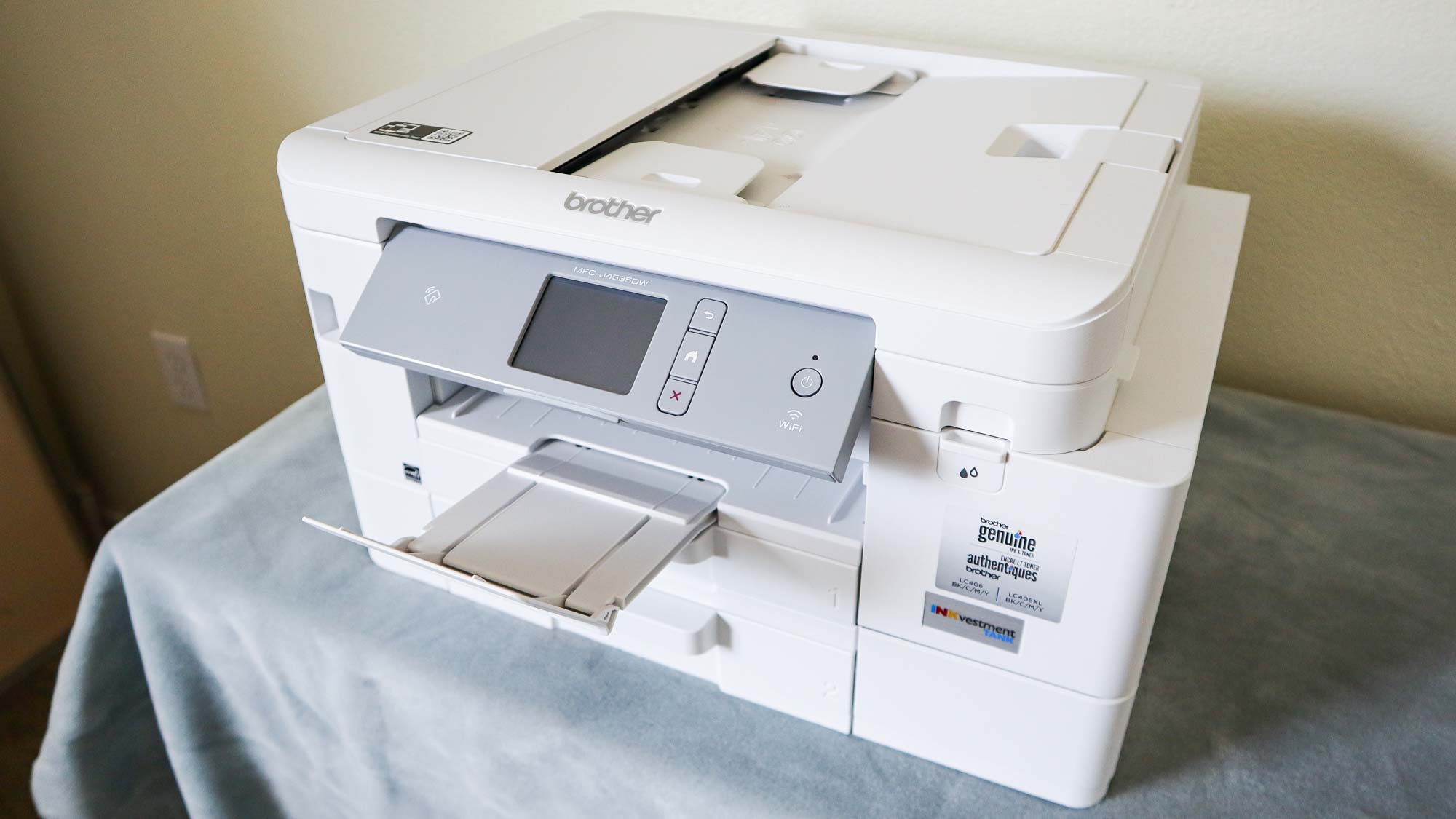
There are two paper trays. Tray 1 holds up to 150 sheets. Tray 2 can hold 250 sheets and is for plain paper only. Coated papers and glossy paper must be loaded into Tray 1. Alternatively, you can load specialty media into the manual feed slot at the back of the unit, but can only do so one sheet at a time. The 100-sheet output tray pulls out from the cover of the top paper tray.

Connections options are plenty. There is a USB port, an Ethernet port, Wi-Fi capability, as well as NFC (near-field communication) on the control panel. The control panel has a 2.7-inch color touchscreen and can be angled upward roughly 45 degrees. The control panel has three physical buttons in addition to the power button: home, previous, and cancel.
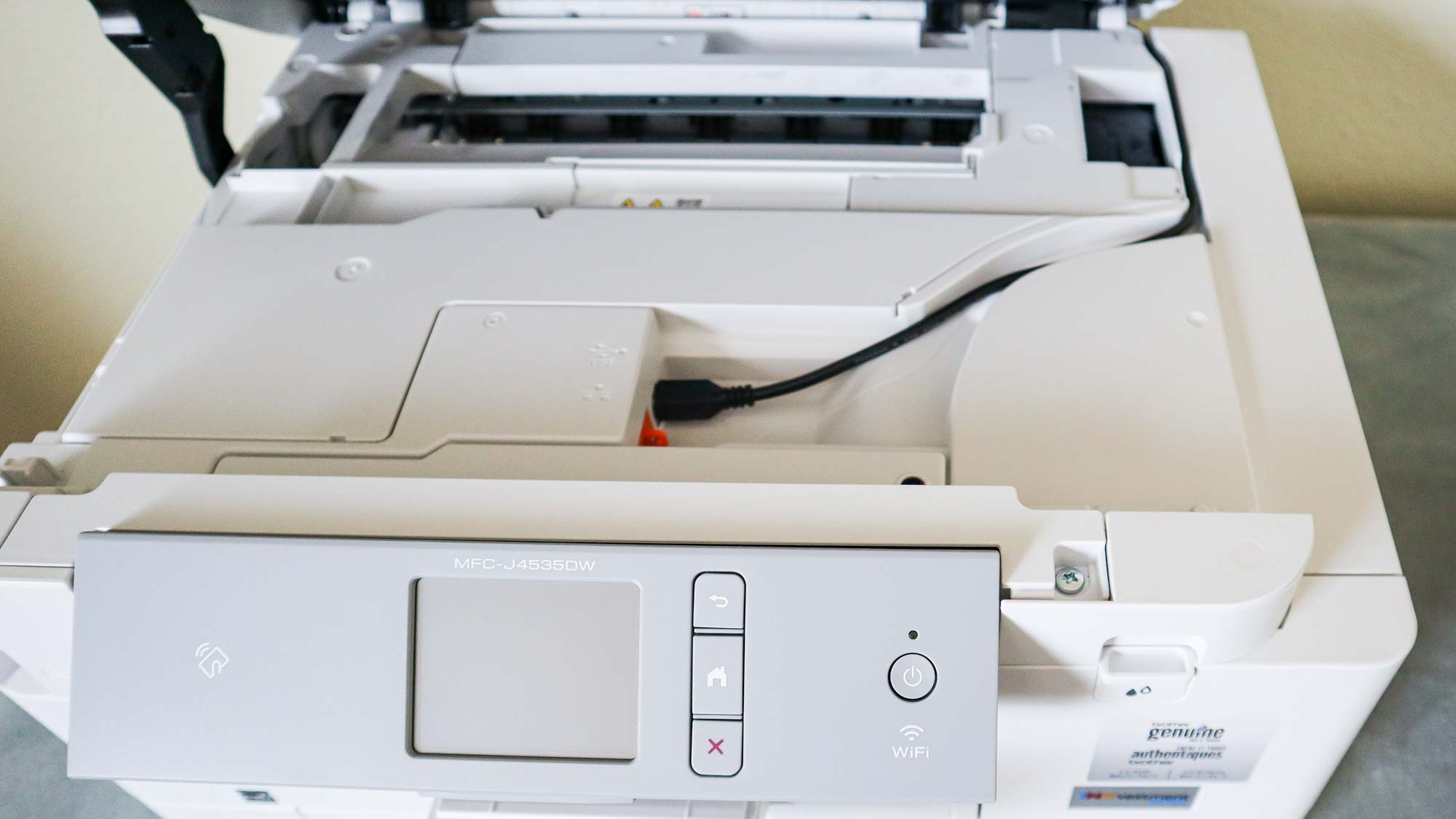
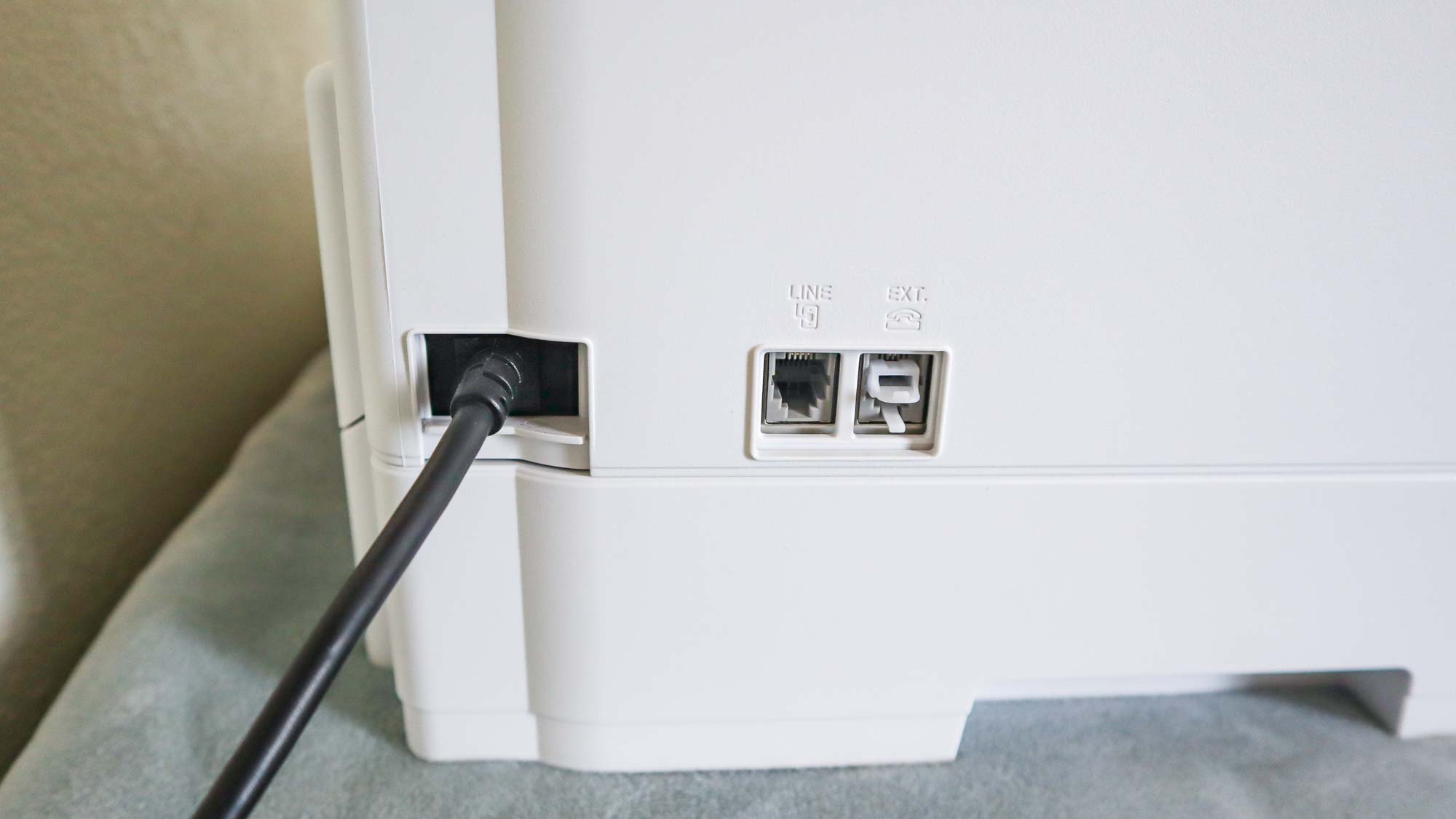
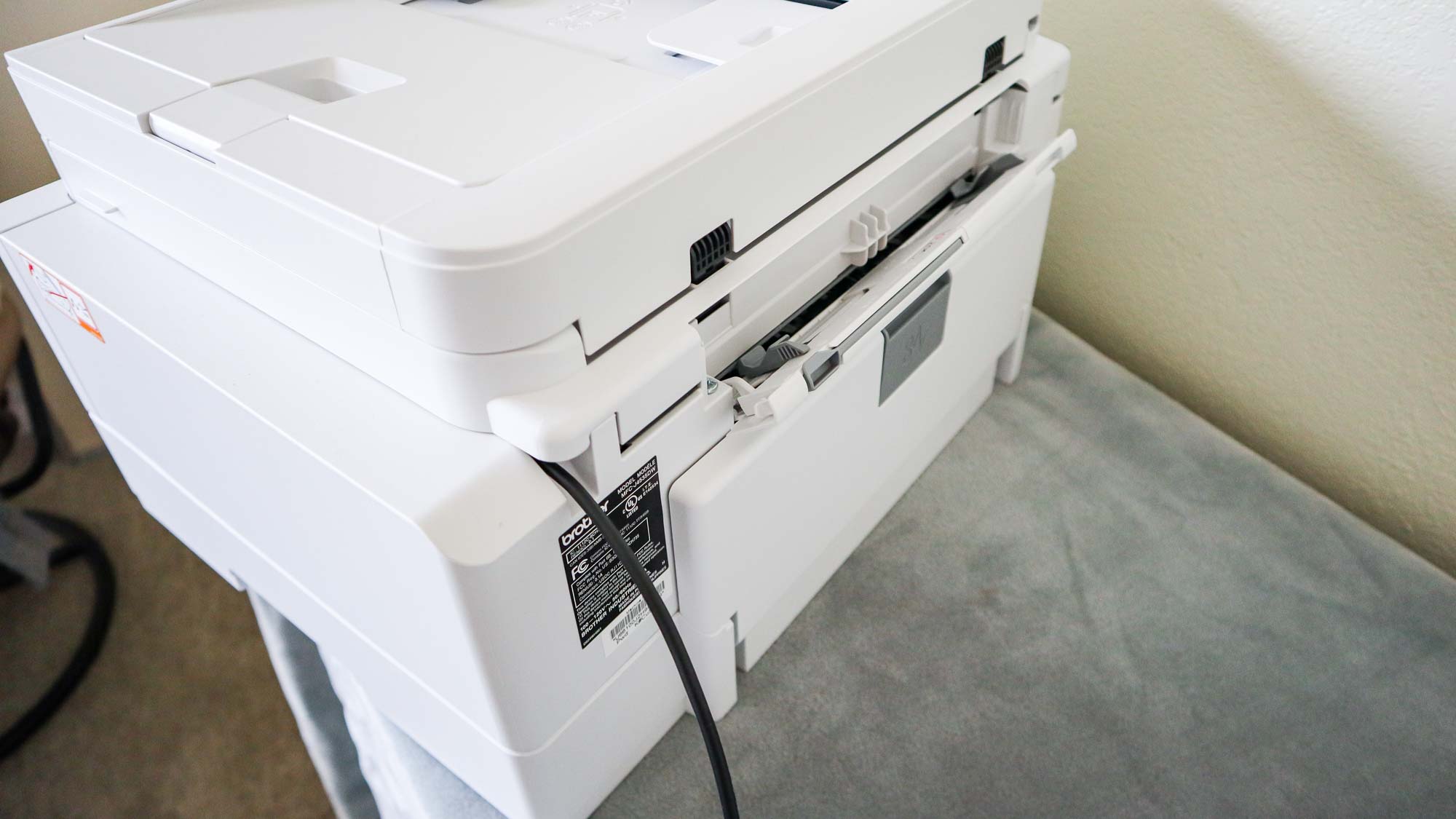
The USB cable routes through the chassis, beneath scanner glass lid, which you must raise to route the cable, which uses up roughly 14 inches of cable in the curved path. You will have to wait for the resistance of the hinge to close lid, which happens slowly. This is convenient because it supports the weight of the ADF when you raise the scanner glass along with the lid. The power cable is permanently attached at the back of the chassis.
Brother MFC-J4535DW review: Print Speed
The MFC-J4535DW turned in impressively fast performance across the board in our tests, handily besting the average on most tasks. It printed our five-page text document in 20.1 seconds, or 14.9 ppm. This was much faster than the average of 32.5 seconds, or 9.2 ppm. By comparison, the similarly priced Canon Pixma G6020 (which has refillable ink tanks), printed text at roughly average speed.
Similarly, the Brother printed our six-page PDF of mixed text and color graphics in 51.3 seconds, or 7 ppm—twice as fast as the average of 2 minutes and 12 seconds (or, 2.7 ppm). By comparison, the Canon G6020 was slower than average, taking 2 minutes and 46 seconds to print the same document.
The MFC-J4535DW was no less impressive at printing glossy photos, making an 8 x 10-inch print of our landscape photo in just 1 minute and 36 seconds—the fastest time of any recently tested inkjet printer, and a fraction of the average of 4 minutes and 22 seconds. By comparison, the Canon G6020 was a little faster than average, taking almost 4 minutes to make the same print.
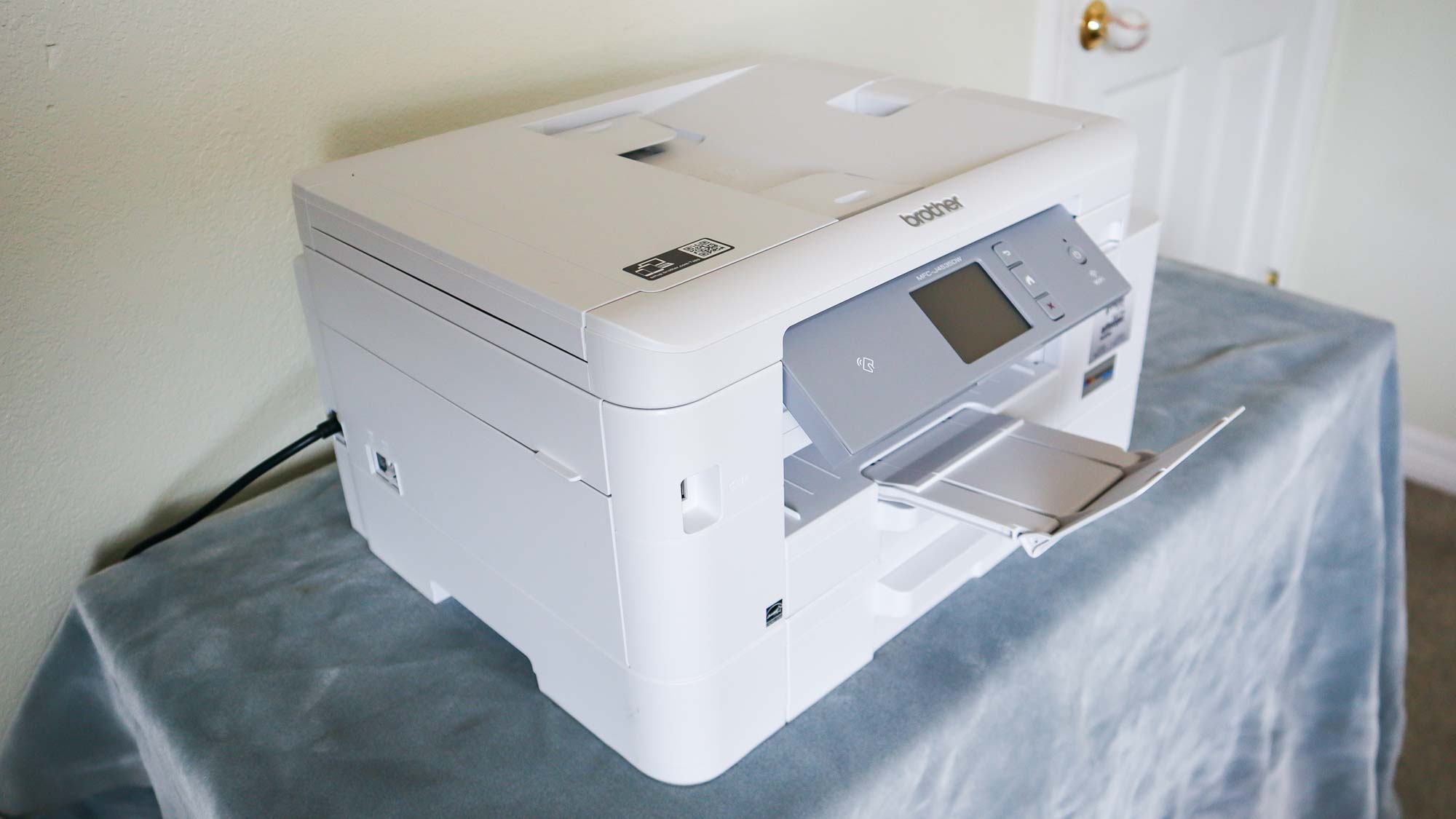
Printing 4 x 6-inch glossy photos was similarly fast. The MFC-J4535DW produced a snapshot at high-quality settings in 1 minutes and 8 seconds, on average—much faster than the category average of nearly 2 minutes. The Canon G6020 was three seconds faster.
Two-sided printing onto plain paper also was quick. The Brother printed 10 pages of text to five sheets of paper in just under a minute, or 10.7 ppm. By comparison, the Canon Pixma G6020 did so at just 2.3 ppm.
The MFC-J4535DW was very fast at duplex printing in color, as well. The Brother printed six pages onto three sheets in just over a minute, or 5.8 ppm. The Canon Pixma G6020 did so at a rather sluggish 1.8 ppm.
Brother MFC-J4535DW review: Copy and Scan Speed
The Brother made color copies at more than twice the average speed. Making a color copy in 13.2 seconds, the Brother handily bested the category average of 33.2 seconds.
Copying in black-and-white also was brisk. Making a copy of a text page in 11 seconds, the MFC-J4535DW easily beat the average of 18.7 seconds. The Canon G6020 was similarly quick on this test, making a copy in 11.3 seconds.
Making copies from the ADF was quick. The Brother made a single-sided copy of a 5-page text document in 38.1 seconds, or 7.9 ppm. Nearly as fast was the HP Envy Inspire 2955e ($270 at review), which made the copy in 41.9 seconds, or 7.2 ppm. (The Canon G6020 does not have an ADF.)
Color scanning was significantly faster than the average of 1 minute and 9 seconds. The Brother made the same color scan to a 600 dpi JPEG in 41.9 seconds. The Canon G6020 did so in 1 minute and 5 seconds. Scanning in black-and-white to PDF format at 300 dpi, the Brother captured a page in 11.5 seconds, versus the category average of 12.1 seconds. The Canon G6020 was significantly quicker, scanning the page in 8.4 seconds.
Brother MFC-J4535DW review: Print Quality
The Brother MFC-J4535DW delivered high image quality in our tests. Text prints looked attractive, with adequately dark letterforms. The edges of letterforms, however, were on the softer side and were not the sharpest we've seen from an inkjet printer. The text quality was good, but not excellent. Text looked just as sharp in duplex prints as on single-sided and prints.
Color graphics also looked attractive. Our first duplex prints of our test PDF, however, exhibited noticeable banding in the graphics. This went away in later testing and after a few rounds, the graphics in the duplex prints were equally attractive as in the single-sided prints. Color graphics were fairly detailed, with attractive textures.
Glossy photos printed with natural-looking colors, attractive saturation, and a good amount of fine detail. Prints of landscapes, people and still life subjects all looked natural and sharp.
Copy quality onto plain paper was not quite as impressive, however. Compared to the laser-print originals, copies of text documents were middle-of-the-road. Text came out lighter and not as sleek as in the original, with edges that were noticeably fuzzier and lumpier. In copies made via the ADF, text edges looked fuzzier than in single copies made on the scanner glass.
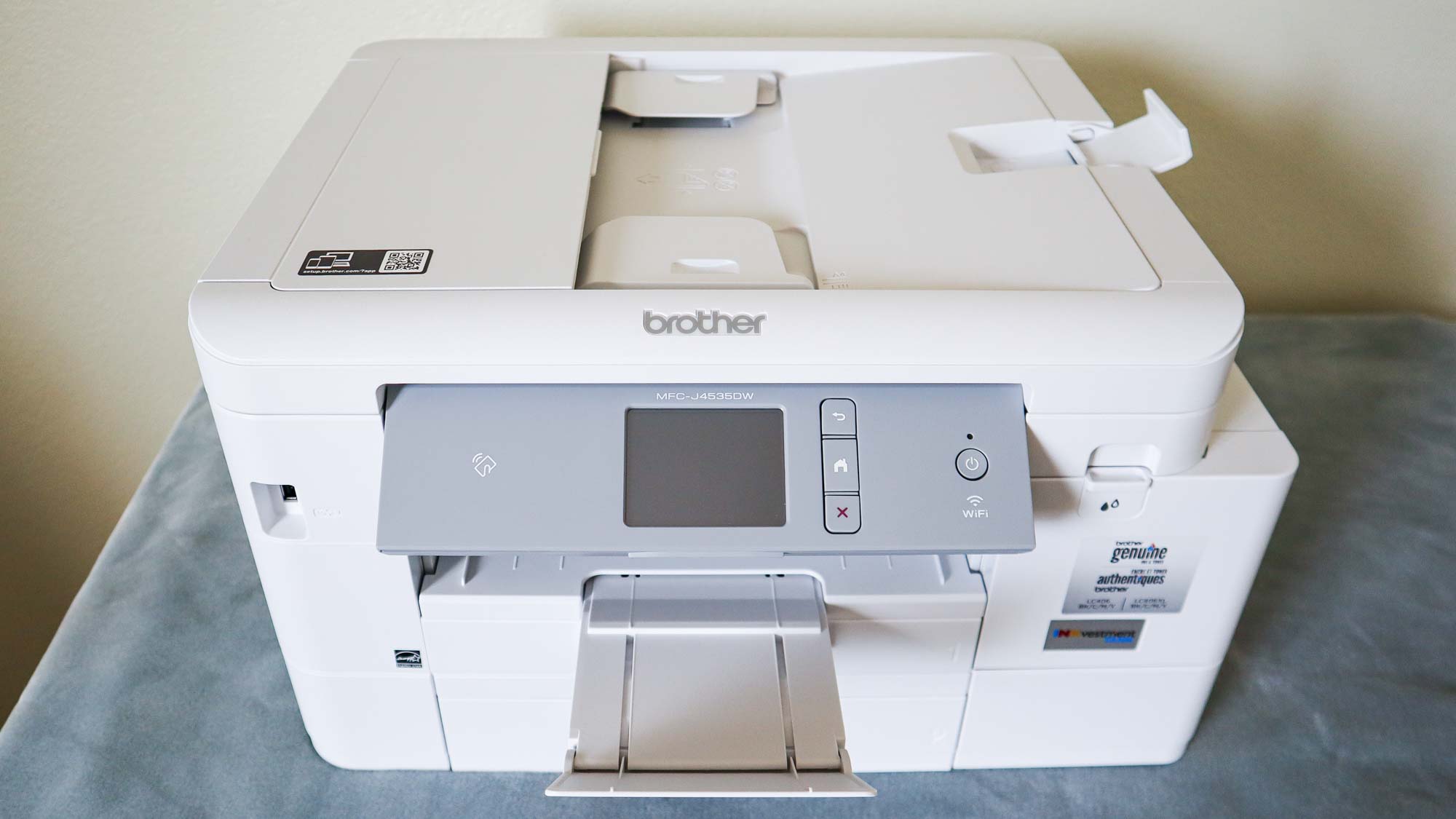
Copies of color documents looked attractive, but were not the most impressive reproductions. Colors did not look as richly saturated and black areas were not as dark as in the original. Details did not look as sharp as in the original, and some pixelation was visible in flat textures.
Scan quality was high overall. In scans of photographs, the Brother captured pleasing exposures on faces with light complexions, although some high mid-tone contour got lost. Shadows were attractively captured, without looking harsh in portraits. Some detail in dark shadow did get lost, however, not as much as some models whose scans were marred by shadows that looked more blocked-up.
The automatic cropping feature worked well on magazine pages and photographs. However, on a graphics-rich cover of a puzzle book, the scanner routinely cropped out most of the page, creating a very small subset of the total image.
Brother MFC-J4535DW review: Ink Cost and Yield
One of the biggest selling points of the Brother MFC-J4535DW is its low ink costs. Because of the high yield of its ink cartridges (dubbed INKvestment Tank Technology), this Brother delivers ink costs far below the average for inkjet printers that use typical ink cartridges (versus refillable ink tank models, which tend to deliver even lower costs per page).
The Brother's black ink cartridge is rated to print 3,000 pages, while the three ink cartridges (cyan, magenta and yellow) are each expected to print 1,500 pages. Based on these ratings, text pages use up 1.1 cents worth of ink per page, while color pages cost 6 cents each, if you purchase the color ink cartridges individually. Buying a CMY three-pack of color cartridges for $65.99 will lower color poage costs to 5.5 cents per page.
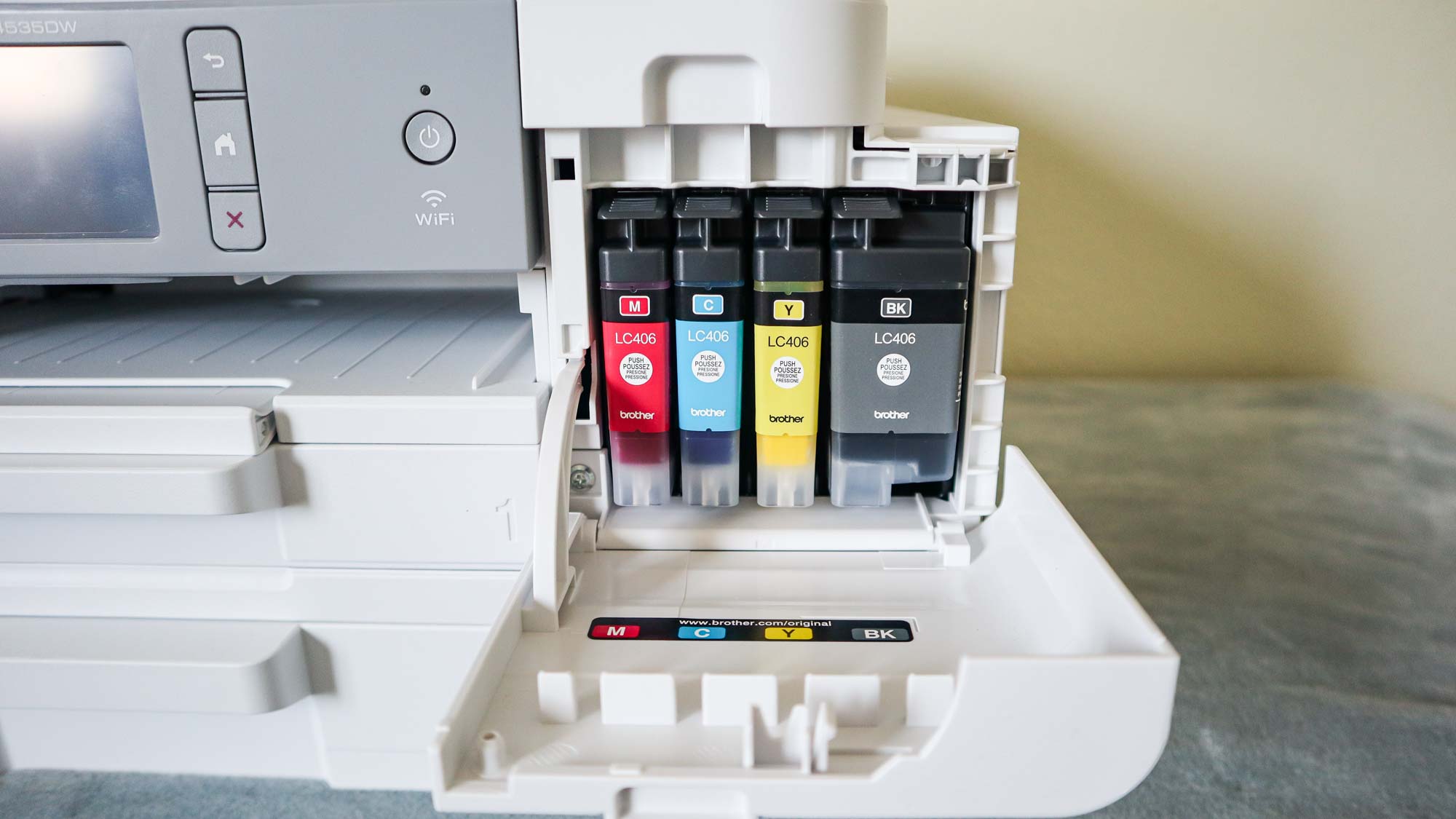
By contrast, models offering high-yield cartridges (which are still of a significantly lower yield that what Brother offers here) average much higher costs per page of 6.2 cents (text) and 15.9 cents (color)—and even higher costs when using their standard cartridges.
The only class of inkjet printer that consistently bests the Brother's high-yield cartridge costs is those with refillable ink tanks. Ink tank models we've reviewed average costs per page of just 0.3 cents (text) and 1 cent (color). The Canon G6020, for example, offers costs per page of just 0.2 and 0.8 cents, respectively.
Brother MFC-J4535DW review: Setup and Software
Brother offers iPrint&Scan software for Windows PCs and the MobileConnect app for mobile devices. Setting up this multi-function device includes printing a print quality check sheet, which you visually inspect for gaps and streaks. You also print an adjustment sheet, which you place on the glass to be scanned.
Installing the software on a PC was straightforward. The software guides you through choosing a connection and software selections. iPrint&Scan allows you to save scanning presets as "workflows", which appear on the software's main page as single-click buttons. The software does not offer workflows for print jobs, unfortunately. Pulling out a paper tray results in a prompt on the printer's touch screen to select the paper type and size. These settings are not, however, relayed to the Windows print driver on a PC, so you will have to enter them again. Having printing presets in iPrint&Scan would save you the need to perform these duplicate selections.
In addition to iPrint&Scan, the PCFax Driver is installed for sending faxes. Also, you can choose to install PaperPort for managing documents and images on your PC.
To put the MFC-J4535DW on my wireless network, I used the 2.7-inch color touchscreen on the printer's control panel, chose the wireless icon, and launched the WPS mode. Pressing the WPS button on my router put the printer on my network and I was done. Adding the Brother to the list of printers on a Mac computer was simple. The all-in-one also supports Wi-Fi Direct.
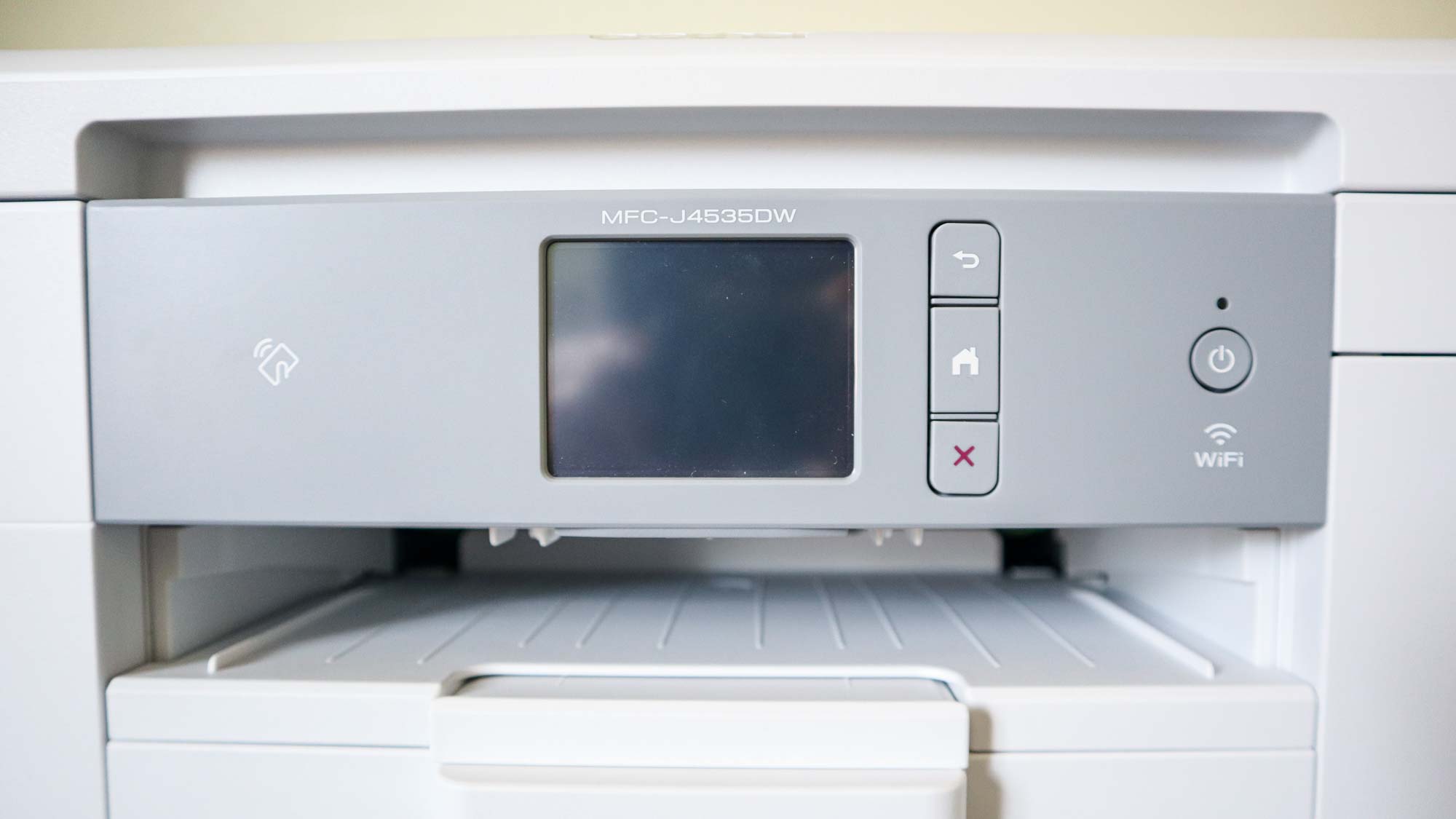
Installing the Brother Connect iOS app on an iPhone was straightforward. The app asked for permission to send personalized push notifications, and offered up to 6 months of free ink if I subscribed to the Refresh EZ Print subscription program. To see if an ink subscription is right for you, see "HP Instant Ink vs. Canon vs. Epson: Are ink subscriptions worth it?"
Although the headline does not mention Brother by name, Brother's Refresh ink subscription is discussed in the article.
The app, which offers printing, scanning and copying capabilities, also offers buttons for performing maintenance and buying. In addition, there is a button for managing a Refresh ink subscription. The all-in-one also works with Alexa.
The MFC-J4535DW is quick to start up, doing so in 7.2 seconds from a complete shutdown. From power-saving mode, the LCD touchscreen illuminates in less than 1 second after pressing the home button.
Brother MFC-J4535DW review: Bottom Line
Outfitted with a document feeder, two paper trays, and a duplexer, the Brother MFC-J4535DW offers a lot of bang for the buck. It's speedy across the board and delivers high image quality. The high-yield ink cartridges deliver very low costs per page compared to most inkjet multifunction printers. As a class, only printers with refillable ink tanks offer lower ink costs.
In addition to its office worthiness (including fax capability), this Brother also produces very attractive photo prints, and does so quickly. Copy quality could use a little improvement, but this is a minor quibble considering this all-in-one's consistently fast printing, copying, and scanning.
